
Stem cell model for early human embryo development
08 September, 2021
The creation of cellular structures similar to blastocysts has enabled KAUST scientists to build an in vitro model that mimics the earliest moments of human embryogenesis.
A blastocyst is the first structure to develop during embryogenesis in mammals. Formed about five days after fertilization and prior to implantation in the womb, blastocysts contain the first three cell lineages of the embryo, which are vital for healthy development and organ formation. Ethical concerns severely constrain the use of human blastocysts to investigate embryo development, which has led to limited understanding of human embryogenesis and its links to developmental defects.
Click here to read the full story.
Image: KAUST scientists create blastocyst-like structures that could generate cells or tissues solely from stem cells to replace lost or damaged tissues.
© 2021 KAUST.